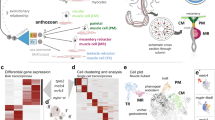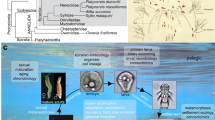Summary
Muscle and brain pigment cell specification was studied by disrupting cell adhesion, cell dissociation, and reaggregation in embryos of the ascidianStyela clava. Treatment of embryos with Ca2+-free sea water between the 2-cell and gastrula stages disrupted blastomere adhesion but did not prevent acetylcholinesterase or muscle actin expression in presumptive muscle cells. Similar treatments initiated between the 2- and 32-cell stages caused more ectoderm cells to express tyrosinase and develop pigment granules than expected from the cell lineage. Whereas 2 pigment cells become the otolith and ocellus sensory organs in normal embryos, up to 33 pigment cells could differentiate in embryos after disruption of cell adhesion. Replacement of Ca2+-free sea water with normal sea water restored cell adhesion and usually resulted in development of embryos containing the conventional number of pigment cells. Dissociation of embryos into single cells between the 2- and 64-cell stages and culture of these cells beyond the fate restricted stage had no effect on the accumulation of muscle actin mRNA and muscle actin synthesis, but blocked pigment cell differentiation. Reaggregation of the dissociated cells did not enhance the number of cells that developed muscle features, but rescued pigment cell development. The results indicate that ascidian muscle cell specification occurs by an autonomous mechanism, whereas pigment cell specification occurs by a conditional mechanism involving cell interactions. In addition, the results suggest that negative cell interactions may restrict the potential for pigment cell development in the ectoderm of cleaving ascidian embryos.
Article PDF
Similar content being viewed by others
Avoid common mistakes on your manuscript.
References
Bates WR (1988) Development of myoplasm-enriched ascidian embryos. Dev Biol 129:241–252
Conklin EG (1905) The organization and cell lineage of the ascidian egg. J Acad Natl Sci Philadelphia 13:1–119
Dale B, Santella L, Tosti E (1991) Gap-junctional permeability in early and cleavage-arrested ascidian embryos. Development 112:153–160
Davidson EH (1991) Spatial mechanisms of gene regulation in metazoan embryos. Development 113:1–26
Deno T, Nishida, Satoh N (1984) Autonomous muscle cell differentiation in partial ascidian embryos according to the newly-verified cell lineages. Dev Biol 104:322–328
Dilly PN (1962) Studies on the receptors in the cerebral vesicle of the ascidian tadpole. 1. The otolith. Quart J Mier Sci 103:393–398
Dilly PN (1964) Studies on the receptors in the cerebral vesicle of the ascidian tadpole. 2. The ocellus. Quart J Micr Sci 105:13–20
Gurdon JB (1988) A community effect in animal development. Nature 336:772–774
Heasman J, Wiley CC, Hausen P, Smith JC (1984) Fates and states of determination of single vegetal pole blastomeres ofX. laevis. Cell 37:185–194
Henry JJ, Amemiya S, Wray GA, Raff RA (1989) Early inductive interactions are involved in restricting cell fates of mesomeres in sea urchin embryos. Dev Biol 136:140–153
Hurley DL, Angerer LM, Angerer RC (1989) Altered expression of spatially regulated embryonic genes in the progeny of separated sea urchin blastomeres. Development 106:567–579
Jacobson AG, Sater AK (1988) Features of embryonic induction. Development 104:341–359
Jeffery WR (1989) Requirement of cell division for muscle actin expression in the primary muscle cell lineage of ascidian embryos. Development 105:75–89
Jeffery WR (1990) An ultraviolet-sensitive maternal mRNA encoding a cytoskeletal protein may be involved in axis formation in the ascidian embryo. Dev Biol 141:141–148
Jeffery WR, Meier S (1983) A yellow crescent cytoskeletal domain in ascidian eggs and its role in early development. Dev Biol 96:125–143
Karnovsky MJ, Roots L (1964) A “direct-coloring” thiocholine method for cholinesterase. J Histochem Cytochem 12:219–221
Khaner O, Wilt F (1990) The influence of cell interactions and tissue mass on differentiation of sea urchin mesomeres. Development 109:625–634
Laidlaw GF (1932) The dopa reaction in normal histology. Anat Rec 53:399–407
Meedel TH, Crowther RJ, Whittaker JR (1987) Determinative properties of muscle lineages in ascidian embryos. Development 100:245–260
Minganti A (1951) Ricerche istochimiche sulla localizzazione del territorio presumtivo degli organi sensoriali nelle larve di Ascidie. Pubbl Staz Zool Napoli 23:52–57
Nishida H (1987) Cell lineage analysis in ascidian embryos by intracellular injection of a tracer enzyme. III. Up to the tissue-restricted stage. Dev Biol 121: 526–541
Nishida H (1990) Determinative mechanisms in secondary muscle lineages of ascidian embryos: development of muscle-specific features in isolated muscle progenitor cells. Development 108:559–568
Nishida H (1991) Induction of brain and sensory pigment cells in the ascidian embryo analyzed by experiments with isolated blastomeres. Development 112:389–395
Nishida H (1992) Developmental potential for tissue differentiation of fully dissociated cells of the ascidian embryo. Roux's Arch Dev Biol 201:81–87
Nishida H, Satoh N (1983) Cell lineage analysis in ascidian embryos by intracellular injection of a tracer enzyme. I. Up to the eight-cell stage. Dev Biol 99:382–394
Nishida H, Satoh N (1985) Cell lineage analysis in ascidian embryos by intracellular injection of a tracer enzyme. II. The 16-and 32-cell stages. Dev Biol 110:440–454
Nishida H, Satoh N (1989) Determination and regulation in the pigment cell lineage of the ascidian embryo. Dev Biol 132:355–367
Nishikata T, Mita-Miyazawa I, Deno T, Satoh N (1987) Muscle differentiation in ascidian embryos analyzed with a tissue-specific monoclonal antibody. Development 99:163–171
Nieuwkoop P (1969) The formation of the mesoderm in urodelean amphibians. I. Induction by the endoderm. Roux's Arch Dev Biol 162:341–373
O'Farrell PH (1975) High resolution two-dimensional electrophoresis of proteins. J Biol Chem 250:4007–4021
Ortolani G (1955) The presumptive territory of the mesoderm in the ascidian germ. Experientia 11:445
Ortolani G, Patricolo E, Mansueto C (1979) Trypsin-induced cell surface changes in ascidian embryonic cells. Regulation of differentiation of a tissue specific protein. Exp Cell Res 122:137–147
Reverberi G, Ortolani G, Farinella-Ferruzza N (1960) The causal formation of the brain in the ascidian larva. Acta Embryol Morphol Exp 3:296–336
Rose SM (1939) Embryonic induction in the ascidia. Biol Bull 77:216–232
Satoh N, Deno T, Nishida H, Nishikata T, Makabe KW (1990) Cellular and molecular mechanisms of muscle cell differentiation in ascidian embryos. Int Rev Cytol 122:221–258
Serras F, Baude C, Moreau M, Guerrier P, van den Biggelaar JAM (1988) Intracellular communication in the early embryo of the ascidianCiona intestinalis. Development 102:55–63
Swalla BJ (1992) The role of maternal factors in ascidian muscle development. Sem Dev Biol 3:287–295
Swalla BJ, Jeffery WR (1990) Interspecific hybridization between an anural and urodele ascidian: Differential expression of urodele features suggests multiple mechanisms control anural development. Dev Biol 142:319–334
Tomlinson CR, Beach RL, Jeffery WR (1987a) Differential expression of a muscle actin gene in muscle cell lineages of ascidian embryos. Development 101:751–765
Tomlinson CR, Bates WR, Jeffery WR (1987b) Development of a muscle actin specified by maternal and zygotic mRNA in ascidian embryos. Dev Biol 123:470–482
Venuti JM, Jeffery WR (1989) Cell lineage and determination of cell fate in ascidians. Int J Dev Biol 33:197–212
West AB, Lambert CC (1975) Control of spawning in the tunicateStyela plicata by variations in a natural light regime. J Exp Zool 195:265–270
Whittaker JR (1973a) Segregation during ascidian embryogenesis of egg cytoplasmic information for tissue specific enzyme development. Proc Natl Acad Sci USA 70:2096–2100
Whittaker JR (1973 b) Tyrosinase in the presumptive pigment cells of ascidian embryos: Tyrosinase accessibility may initiate melanin synthesis. Dev Biol 30:441–454
Whittaker JR (1982) Muscle cell lineage cytoplasm can change the developmental expression in epidermal lineage cells of ascidian embryos. Dev Biol 93:463–470
Whittaker JR, Ortolani G, Farinella-Ferruzza N (1977) Autonomy of aceylcholinesterase differentiation in muscle lineage cells of ascidian embryos. Dev Biol 55:196–200
Author information
Authors and Affiliations
Rights and permissions
About this article
Cite this article
Jeffery, W.R. Role of cell interactions in ascidian muscle and pigment cell specification. Roux's Arch Dev Biol 202, 103–111 (1993). https://doi.org/10.1007/BF00636535
Received:
Accepted:
Issue Date:
DOI: https://doi.org/10.1007/BF00636535




